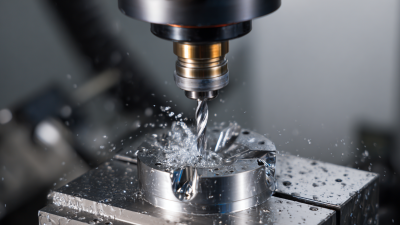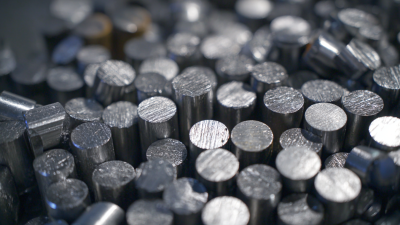Maximizing Efficiency with Cutting Tools Understanding the Impact of Tool Material Selection on Machining Performance
Table of Contents
- Understanding Different Tool Materials and Their Properties
- Impact of Tool Geometry on Machining Efficiency
- Choosing the Right Coating for Enhanced Durability
- Optimizing Cutting Parameters for Various Materials
- Innovative Technologies in Cutting Tool Design
- Evaluating Cost-Effectiveness of Tool Material Choices
- Exploring the Efficiency and Performance of Iscar SNMG120408-GN IC9150 Inserts in Precision Machining: Insights from Industry Reports
- FAQS
- Conclusion
- Related Posts
In the ever-changing world of manufacturing, choosing the right cutting tools is so important if you want to boost performance and get things running smoothly. Did you know that, according to Grand View Research, the global market for cutting tools is expected to hit around $41 billion by 2025? That really shows just how much demand there’s for precise engineering across different industries. Picking the right tool material isn’t just about lasting longer or resisting wear—it also influences how fast and efficiently you can machine your parts. Here in China, Jinan Terry CNC Tool Limited Company is leading the way when it comes to exporting top-quality CNC cutting tools. When manufacturers understand how the choice of tool material affects the final outcome, they can fine-tune their processes, save some money, and get more done in the same amount of time—especially in such a competitive market. In this article, I’ll be talking about some best practices for really maximizing efficiency by making smart decisions when it comes to selecting cutting tools.

Understanding Different Tool Materials and Their Properties
Picking the right tool material is a big deal when it comes to machining — it really makes a difference in how productive and efficient your work is. There are several options out there, like high-speed steel (HSS), carbide, ceramic, and cermet, each with their own perks that make them suitable for different jobs. For example, HSS tools are pretty tough and can handle high temperatures well, but they tend to wear out faster than some other types. They work great for prolonged cutting at moderate speeds, especially if you need something reliable over the long haul. On the flip side, carbide tools are super resistant to wear and are very rigid, making them perfect for high-speed cutting. This means you can get things done faster, and the tools last longer under tough conditions.
Now, ceramic and cermet tools are a bit more specialized — not as common, but they do have their moments. Ceramic tools, for instance, shine in high-temperature situations because they’re incredibly hard and resistant to wear. The catch? They can be pretty brittle, so they’re not the best choice for complex shapes or tricky geometries. Cermets are kind of a happy medium — they combine properties of ceramics and metals, giving you a good mix of hardness and toughness. That makes them ideal if you're working with materials that are hard to machine and need precise cuts. Basically, understanding the ins and outs of these different tool materials is key for optimizing your machining and making sure everything runs smoothly and efficiently in manufacturing. It’s all about matching the right tool to the task at hand.”
Maximizing Efficiency with Cutting Tools Understanding the Impact of Tool Material Selection on Machining Performance
| Tool Material | Hardness (HRC) | Tensile Strength (MPa) | Thermal Conductivity (W/m·K) | Wear Resistance (mg) | Typical Applications |
|---|---|---|---|---|---|
| HSS | 62 | 900 | 20 | 50 | General machining, drilling |
| Carbide | 90 | 2500 | 25 | 10 | High-speed machining, metal cutting |
| Ceramic | 85 | 3000 | 30 | 5 | Hard materials, ceramics machining |
| Cobalt | 70 | 1300 | 15 | 25 | Alloy steel machining, drilling |
| Cermet | 80 | 1800 | 28 | 15 | Finishing operations, hard turning |
Impact of Tool Geometry on Machining Efficiency
You know, the shape and design of cutting tools really make a big difference when it comes to machining efficiency. Things like the angles, the size, and the overall shape of the cutting edges can totally change how smoothly or quickly the process goes.
When tools are designed just right, they help form chips better, cut with less force, and even wear out way less over time. For manufacturers, getting a good grip on what kind of tool geometry to use is kinda essential if you want your work to be super precise and leave a nice finish on your parts.
At Jinan Terry CNC Tool Limited Company, we totally get how important tool geometry is with our range of CNC cutting tools. We’re actually one of China’s main export agents for CNC tools, and we’ve got a bunch of different geometries to suit all sorts of machining needs. We’re all about quality, so our clients know they’re getting tools that deliver top performance—helping them ramp up production and cut down on downtime. By paying close attention to both the material and the geometry of our tools, we help our customers achieve really awesome results across a bunch of different applications.
Choosing the Right Coating for Enhanced Durability
Choosing the right coating for your cutting tools really makes a difference when it comes to how long they last and how well they perform during machining. The kind of coating you pick can affect how much friction there is, how resistant the tool is to wear, and how well it handles heat — all of which can boost your tool lifespan and productivity. When you're deciding on a coating, it’s a good idea to think about the material you’re working with, the cutting speeds, and the specific machining process. For example, titanium nitride (TiN) is well-known for being super hard and works great for general-purpose setups. On the other hand, titanium carbonitride (TiCN) offers better wear resistance and is usually better if you’re dealing with tougher materials.
A few tips to keep in mind: try to evaluate your machining environment and what you need the tool to do. If you’re doing high-speed stuff, look for coatings that can handle the extra heat. Also, don’t forget to consider how easy it is to re-coat or replace the tools down the line. It’s often smart to test out a few coatings on a small scale first — that way, you can see how they perform before going all in.
Getting the right coating isn’t just about making your tools last longer. It can also improve the surface finish and help you hit tighter tolerances in your final products. If you’re machining really abrasive materials, coatings like aluminum oxide (Al2O3) can add extra protection and help extend tool life. And hey, it’s worth keeping an eye on new developments in coating tech — staying updated can lead to some serious gains in cutting efficiency and overall results.

Optimizing Cutting Parameters for Various Materials
When it comes to optimizing machining performance, picking the right cutting parameters for different materials is super important. For example, if you're working with softer stuff like aluminum, you'll usually want to keep cutting speeds somewhere between 30 and 100 meters per minute. But for tougher materials like titanium, you’ll need to slow things down quite a bit—think around 15 to 50 meters per minute, tops (according to Machinery’s Handbook, 30th Edition). Using the correct feed rate and depth of cut can really make a difference too, not just for the tool’s lifespan but also for that smooth surface finish you’re aiming for. If you set your feed rate right, it’ll help you cut effectively without putting too much stress on your tools, which, in turn, boosts your productivity.
A quick tip—always check the manufacturer’s recommendations for your tools and materials when you’re starting out. Then, keep an eye on how things go during the process and don't be afraid to do some trial runs. That way, you can tweak your settings and get it just right.
Also, factors like how you cool the material and what kind of tool you're using really make a difference. For example, high-speed steel (HSS) tools work well with carbon steels, but if you’re dealing with super alloys that generate more heat, carbide tools are a smarter choice since they handle higher temperatures better. According to a recent paper from the International Journal of Advanced Manufacturing Technology, dialing in these parameters not only shortens cycle times but can also cut down on tool wear by up to 30%. That’s a huge boost for overall efficiency in machining operations.
Maximizing Machining Efficiency: Tool Material and Cutting Parameters
Innovative Technologies in Cutting Tool Design
You know, the whole world of cutting tool design has really been turned upside down thanks to some pretty incredible tech advances. These days, materials like carbide, ceramic, and cermet composites are crafted to handle higher temperatures and resist wear way better than ever before. Honestly, that’s a big deal because it means tools last longer, and machines don’t have to stop as often, making production way smoother. Plus, adding coatings like titanium nitride or a diamond-like carbon layer gives these tools even more edge—helping to get a better finish and make chip removal much easier.
And it doesn’t stop there. The fun part is these smart cutting tools with sensors are starting to change the game. They can actually monitor what's happening in real-time—like, keeping an eye on wear and spotting potential failures early on. This kind of real-time feedback means manufacturers can tweak their settings on the fly, leading to more precise work and less wasted material. Honestly, by embracing these cutting-edge designs and tech, machinists can work more efficiently and stay ahead of the competition. It’s pretty exciting stuff!

Evaluating Cost-Effectiveness of Tool Material Choices
Picking the right material for your cutting tools really makes a difference when it comes to getting the best performance out of your machining process. Nowadays, more industries are focusing on saving costs, so it’s super important to understand how your choice of tool material could impact your budget. There have been plenty of studies—especially on eco-friendly infrastructure options—that show you really need to consider whether the benefits outweigh the costs if you’re serious about being sustainable. It's a lot like how decision-makers weigh the economic viability of climate change strategies; manufacturers need to look at how well their tools perform and how long they last to get the most bang for their buck.
A few tips worth keeping in mind: first, think about durability. Choosing tougher materials might cost more upfront but can save you a lot in the long run because you won’t have to replace tools as often. Also, make sure the materials you pick are compatible with your specific machining processes—that can seriously boost efficiency and cut down on waste.
With all the new tech coming into manufacturing, doing a thorough cost-and-benefit analysis is more relevant than ever. By taking these evaluations into account, manufacturers can make smarter choices that not only boost productivity but also keep costs in check. These kinds of frameworks really help in crafting strategies that are both effective and sustainable, guiding businesses toward smarter, more economical operations.
Exploring the Efficiency and Performance of Iscar SNMG120408-GN IC9150 Inserts in Precision Machining: Insights from Industry Reports
The Iscar SNMG120408-GN IC9150 inserts represent a leading-edge solution in precision machining, exemplifying exceptional wear resistance and an extended tool life. According to recent industry reports, tools made from high-grade materials such as these can withstand the significant rigors of machining hard steel and stainless steel components, as well as cast iron and nonferrous materials. The IC9150 grade's tailored coating technology enhances performance in high-speed applications, facilitating efficient cutting operations without compromising on the stability required for productive turning.
Data from a recent machining efficiency study indicates that utilizing Iscar's SNMG120408-GN inserts can lead to a 30% reduction in cutting force compared to standard inserts. This characteristic is crucial for maintaining the integrity of the workpiece, especially in precision applications where any deviation can result in costly defects. The high toughness of ISCAR tools allows for secure machining across a variety of materials, ensuring reliable performance in both automated and manual settings. Furthermore, their compatibility with ISO and ANSI standards makes them accessible for a wide range of applications, solidifying their status as a preferred choice in the manufacturing industry.
FAQS
: Tool geometry plays a critical role in machining efficiency by influencing chip formation, reducing cutting forces, and minimizing tool wear, ensuring high precision and better surface finishes.
Jinan Terry CNC Tool Limited Company emphasizes the importance of tool geometry in their range of CNC cutting tools, offering various designs that cater to different machining needs for maximum efficiency and minimal downtime.
When selecting a coating, consider the material being machined, cutting speeds, the type of machining process, and the specific machining environment to ensure optimal performance.
Titanium nitride (TiN) is known for its high hardness and is ideal for general-purpose machining, whereas titanium carbonitride (TiCN) provides better wear resistance, suitable for tougher materials.
The right coating can enhance durability, reduce friction, improve wear resistance, and increase thermal stability, leading to longer tool life and increased productivity.
For high-speed applications, prioritize coatings that can withstand elevated temperatures to ensure tool effectiveness and longevity.
Yes, it is advisable to experiment with different coatings on a small scale to understand their performance before committing to larger-scale use.
The right coating can also enhance surface finishes and ensure tighter tolerances in the final product, contributing to overall machining quality.
Keeping up-to-date with advancements in coating technologies enables informed decisions that can lead to significant improvements in cutting efficiency and tool performance.
Understanding tool geometry and coatings is essential for manufacturers to achieve optimal machining performance, high precision, and better surface finishes in their operations.
Conclusion
When it comes to boosting machining efficiency, understanding the role of cutting tools is a big deal. Each tool material has its own unique perks, which can really affect how well they perform in different setups. Plus, the shape and design of the tools matter a lot — clever geometries can make cutting smoother, cut down on wear and tear, and just make the whole process more efficient. And don’t forget about coatings! Picking the right coating can seriously boost their durability so they stand up to tough jobs longer.
At Jinan Terry CNC Tool Limited Company, we get how important all these factors are in manufacturing. We focus on tweaking cutting parameters to match different materials and use innovative tech in our tool designs. The goal? To give our clients solutions that not only perform great but are also cost-effective when it comes to choosing materials. With our expertise, we’re proud to be a top exporter of CNC cutting tools, helping manufacturers get the most out of their operations with efficiency that’s hard to beat.
Related Posts
-

Ultimate Guide to Choosing the Right Carbide Cutting Inserts for Your Projects
-

7 Best Tips to Maximize the Efficiency of Carbide Tool Inserts
-

How to Select the Best Cnc Indexable Carbide Inserts Wnmg for Your Machining Needs
-

Unlocking Precision: The Future of Machining with Seco Carbide Inserts
-

Exploring Cnc Insert Types at the 138th China Import and Export Fair 2025
-

How to Select the Right PDC Blanks for Optimal Drill Bit Performance

Ethan
-

Phone
-

E-mail
-

Skype

